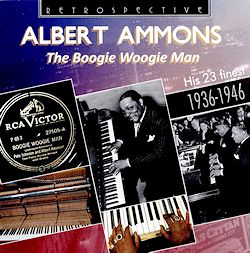 BUY NOW AmazonUK AmazonUS |
ALBERT AMMONS The Boogie Woogie Man; His 23 finest 1936-46 |
Boogie Woogie Stomp
Early Mornin' Blues
Boogie Woogie Prayer, Parts 1 and 2
Shout For Joy
Boogie Woogie Blues
Woo Woo
Mighty Blues
St. Louis Blues
Bass Goin' Crazy
Pinetop’s Boogie Woogie
Chicago In Mind
Cafe Society Rag
Boogie Woogie Man
Barrelhouse Boogie
Cuttin' The Boogie
Sixth Avenue Express
Blues In The Grove
The Breaks
Jammin' The Boogie
Bottom Blues
Bedroom Blues
Swanee River Boogie
If you have ASV’s Living Era CD AJA 5305 released two decades ago, then you have this disc as it’s the latest in a long line of ASV reissues under the Retrospective banner.
Albert Ammons (1907-49) needs no introduction; a propulsive exponent of Boogie who formed a High Priest triumvirate with Meade Lux Lewis and Pete Johnson and who recorded inter alia for Decca, Vocalion, Blue Note, Brunswick, Solo Art, Victor, Commodore, Mercury and just about any label that had house room for Ammons’ brand of unstoppable bravura.
Rightly there is room for both incarnations of his Rhythm Kings. The earlier version is led by trumpeter Guy Kelly whose playing, especially Blues playing, is always of interest to lovers of earlier jazz and he has with him Dalbert Bright playing clarinet (not bad) and alto (noodling). The marvellous bassist Israel Crosby appeared in both versions of this band, whilst Jimmy Hoskins was the drummer in the 1936 band – not a subtle player, but then subtlety is not Boogie’s raison d’être. The later Rhythm Kings featured one of the supreme Blues stylists, Hot Lips Page, alongside a master of drollery, Vic Dickenson, and the fiery tenor of Don Byas. Drummer Big Sid Catlett lays down a righteous backbeat for Page on Jammin’ the Boogie. The Rhythm Kings was a portable combo, and a small-scale one too; in the form of just Ammons, alto player Artie Starks and rhythm (including Lonnie Johnson) it accompanied Classic Blues singer, the veteran Sippie Wallace in the suggestive Bedroom Blues.
Inevitably Boo-Woo is here, where Harry James adds his cutting trumpet to the genre, and a single example from the Blue Note Port of Harlem Jazzmen session where they – and they include Frankie Newton and JC Higginbotham but here sans Sidney Bechet – perform a slow Mighty Blues.
These band sides contextualize the solo, duo and trio offerings from Ammons, Lewis and Johnson, and the Ammons-Johnson-Lewis trio – this last group being billed as ‘The Boogie Woogie Boys’. Boogie Woogie Prayer, with the trio, took both sides of a Vocalion 10”, and was recorded at the same session Ammons cut his solo classic Shout for Joy (the one that so impressed George Shearing). His Solo Art session in April 1939 is splendid and the duos with Johnson in May 1941 were recorded for Victor, a marker of the popularity Boogie was enjoying. The most revealing, musically, is Sixth Avenue Express, a divergent Boogie that plays with the form in a way that the more straight-ahead numbers don’t. By 1946 he was, however, recording some good time drivel for Mercury – Swanee River Boogie – ie Old Folks at Home – and Twelfth Street Boogie that both show how easily and regrettably the form could degenerate into pap.
Still, let’s not end on that sad note. It’s far better to recall the incendiary drive of this master at the peak of his powers in these evergreen examples of his unstoppable talent.
Jonathan Woolf